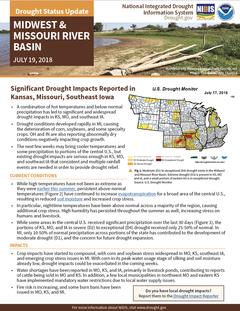Drought Status Update: Midwest and Missouri River Basin - July 19, 2018
Significant Drought Impacts Reported in Kansas, Missouri, Southeast Iowa
- A combination of hot temperatures and below-normal precipitation has led to significant and widespread drought impacts in KS, MO, and southeast IA.
- Drought conditions developed rapidly in MI, causing the deterioration of corn, soybeans, and some specialty crops. OH and IN are also reporting abnormally dry conditions negatively impacting crop growth.
- The next few weeks may bring cooler temperatures and some precipitation to portions of the central U.S., but existing drought impacts are serious enough in KS, MO, and southeast IA that consistent and multiple rainfall events are needed in order to provide drought relief.
CURRENT CONDITIONS
- While high temperatures have not been as extreme as they were
- earlier this summer, persistent above-normal temperatures (Figure 2) have continued to increase evapotranspiration for a broad area of the central U.S., resulting in reduced soil moisture and increased crop stress.
- In particular, nighttime temperatures have been above normal across a majority of the region, causing additional crop stress. High humidity has persisted throughout the summer as well, increasing stress on humans and livestock.
- While some areas in the central U.S. received significant precipitation over the last 30 days (Figure 3), the portions of KS, MO, and IA in severe (D2) to exceptional (D4) drought received only 25-50% of normal. In MI, only 10-50% of normal precipitation across portions of the state has contributed to the development of moderate drought (D1), and the concern for future drought expansion.
IMPACTS
- Crop impacts have started to compound, with corn and soybean stress widespread in MO, KS, southeast IA, and emerging crop stress issues in MI. With corn in its peak water usage stage of silking and soil moisture already low, drought impacts could be exacerbated in the coming weeks.
- Water shortages have been reported in MO, KS, and IA, primarily in livestock ponds, contributing to reports of cattle being sold in MO and KS. In addition, a few local municipalities in northwest MO and eastern KS have implemented mandatory water restrictions due to local water supply issues.
- Fire risk is increasing, and some burn bans have been issued in MO, KS, and MI.
OUTLOOK
- Cooler conditions are more likely in the 8-14 Day Temperature Outlook (Figure 4), leading to potential relief in some areas for crops and animals. Cooler temperatures will also be beneficial for crops by reducing their water usage and potential yield loss.
- While there is a chance for above-normal precipitation in some areas of the central U.S., consistent and multiple rainfall events would be needed for widespread drought improvement in KS, MO, and southeast IA.
- The Seasonal Drought Outlook for July 19-October 31 (Figure 5) shows drought persistence in the drought areas of KS, MO, southeast IA, and MI, and indicates that drought development is likely throughout much of MO and into western IL.
Drought Resources
Find your state climatologist
Kansas State University Extension
University of Missouri Extension
Iowa State University Extension


